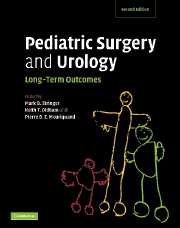Book contents
- Frontmatter
- Contents
- List of contributors
- Acknowledgments
- Preface
- Part I General issues
- Part II Head and neck
- Part III Thorax
- Part IV Abdomen
- Part V Urology
- Part VI Oncology
- Part VII Transplantation
- Part VIII Trauma
- Part IX Miscellaneous
- 71 Vascular access
- 72 Myelomeningocele and hydrocephalus
- 73 Outcomes after maternal–fetal surgery
- 74 Conjoined twins
- Index
- Plate section
- References
71 - Vascular access
from Part IX - Miscellaneous
Published online by Cambridge University Press: 08 January 2010
- Frontmatter
- Contents
- List of contributors
- Acknowledgments
- Preface
- Part I General issues
- Part II Head and neck
- Part III Thorax
- Part IV Abdomen
- Part V Urology
- Part VI Oncology
- Part VII Transplantation
- Part VIII Trauma
- Part IX Miscellaneous
- 71 Vascular access
- 72 Myelomeningocele and hydrocephalus
- 73 Outcomes after maternal–fetal surgery
- 74 Conjoined twins
- Index
- Plate section
- References
Summary
Introduction
The intravascular administration of drugs has a long history, dating back to at least the seventeenth century, when William Harvey defined vascular anatomy (Exercitatio Anatomica De Motu Cordis et Sanguinis). However, early techniques were crude, relying on natural materials such as quill and bladder. A significant advance occurred in 1853, when Alexander Wood employed the recently developed needle and syringe to give intravenous medications. Contemporary practice is based on these early developments, but it is only in the last 50 years that progressive refinements of equipment and technique have allowed the routine use of vascular access through various routes. In 1952 Aubaniac introduced a technique for central venous catheterization, and bravely stated “elle est strictement sans danger”. Many subsequent publications have demonstrated the overconfidence of this pronouncement but, at the same time, reviews of the various procedures have shown that vascular access can be performed effectively with a high degree of safety. In the UK, the National Institute for Clinical Excellence (NICE) has issued guidance which recommends the use of ultrasound guidance for percutaneous cannulation of the internal jugular veins in all patients over 3 kg. Table 71.1 outlines the range of vascular access procedures currently in common usage. Unfortunately, there are very little data on long-term outcomes. In particular, there are no long-term longitudinal cohort studies in children. Our current knowledge is therefore based on extrapolation from published short- to mid-term data.
- Type
- Chapter
- Information
- Pediatric Surgery and UrologyLong-Term Outcomes, pp. 947 - 957Publisher: Cambridge University PressPrint publication year: 2006

